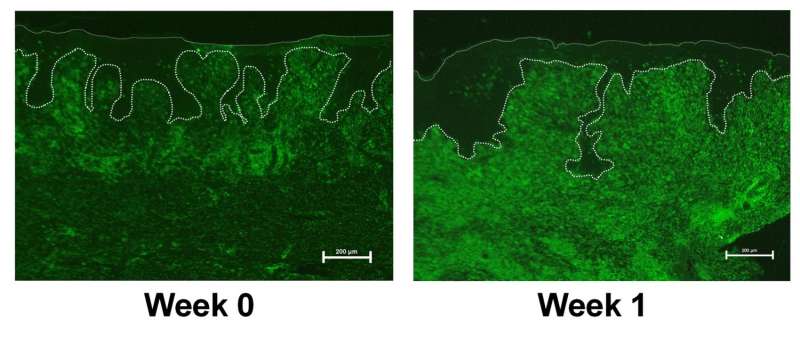Apligraf demonstrates significant change in chronic wound's genomic profile

Apligraf - an FDA-approved, bioengineered living-cell therapy from Organogenesis Inc. - has become the first wound-healing therapy to demonstrate a significant change in the genomic profile of a treated non-healing wound, according to new research published in the peer-reviewed journal Science Translational Medicine. The analysis from a multidisciplinary research team at the University of Miami, titled "A bioengineered living cell construct activates an acute wound healing response in venous leg ulcers," provides new insight on what happens to a wound's genomic profile when Apligraf is applied to a chronic venous leg ulcer (VLU), when compared to standard care with compression therapy alone. The analysis found that the application of Apligraf in conjunction with compression therapy altered specific molecular and cellular responses in the wound environment, converting the chronic wound profile to resemble an acute, healing wound profile.
"This is the first time this type of detailed gene expression analysis has been conducted to evaluate the response to a wound healing modality," said Marjana Tomic-Canic, PhD, Director of the Wound Healing and Regenerative Medicine Research Program at the University of Miami. "Our findings show that Apligraf can shift the gene expression profile of a chronic, non-healing ulcer to resemble a profile similar to that of an acute, healing wound. This is important as we now can use this as a guiding tool to understand healing of a chronic wound and mechanisms by which therapies can work."
The research consisted of a prospective, randomized, controlled clinical trial that analyzed VLUs with less than 40 percent area reduction after four weeks of treatment with standard care with compression therapy. Biopsies were performed at the edge of the wound to define the profile of the non-healing VLUs. Patients were then randomized into: a) a group receiving treatment with standard of care therapy alone; and b) a group receiving treatment with Apligraf and standard of care therapy. At Day 7 after Apligraf was applied, biopsies were performed again to assess changes in the ulcer profile. Results of the biopsies from this study were compared to the existing data set for biopsies taken from acute, healing wounds.
The study concluded that, for the group treated with both Apligraf and standard of care therapy, Apligraf modulated inflammatory and growth factor signaling and activated keratinocytes at the wound edge; thus successfully shifting the wound environment from a chronic, non-healing ulcer microenvironment to a distinctive healing milieu resembling that of an acute, healing wound.
"The acceptance of this groundbreaking research into the prestigious Science Translational Medicine journal underscores our company's commitment to developing safe, effective, and evidence-based advanced wound care products for clinicians," said Gary S. Gillheeney, Sr., President & CEO of Organogenesis. "This study provides valuable information to researchers and clinicians working to promote healing in chronic wounds."
According to a new report from THE SAGE GROUP, more than three million U.S. adults suffer from venous ulcers. The cost of venous disease represents a significant burden on patients and the U.S. economy, with venous ulcers alone costing at least $21 billion annually.
More information: Rivka C. Stone et al. A bioengineered living cell construct activates an acute wound healing response in venous leg ulcers, Science Translational Medicine (2017). DOI: 10.1126/scitranslmed.aaf8611



















